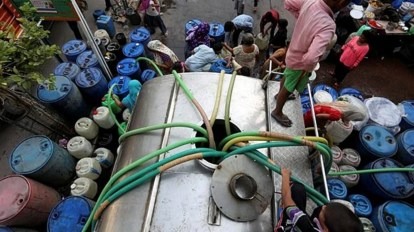
Mumbai Water Crisis: Understanding the Urgency
In recent times, Mumbai has been grappling with a severe water crisis, reminiscent of the struggles witnessed in Bengaluru, the country’s IT hub. The situation has escalated to the extent that people are forced to stand in long queues for just a few drops of water. Amidst this turmoil, the Brihanmumbai Municipal Corporation (BMC) announced a five percent water cut on Monday. Moreover, a further 15 percent water cut has been declared in Mumbai on Tuesday, March 19th, intensifying the concerns of the populace.
Reasons Behind BMC’s Water Cut
The decision by the Brihanmumbai Municipal Corporation (BMC) to implement water cuts stems from maintenance work carried out before the monsoon season. According to municipal authorities, the additional cut in water supply across the city is due to a shortage of water at the Powai Dam in Thane district. In a statement released on Monday evening, BMC stated that once water is received from the Bhatsa reservoir, situated approximately 60 kilometers away from the city, the water supply will be restored.
Dam’s Rubber Bladder Dysfunction
The municipal corporation revealed in a press release that one of the rubber bladders of the 32 gates of the Powai Dam had malfunctioned, leading to the initiation of water flow on December 16th. Repairing the bladder necessitated reducing the water level in the dam to 31 meters. Although the rubber bladder has been repaired, the water level at the pumping plant in Panjarpol, responsible for pumping water to Mumbai, is inadequate. Despite water being released from the Bhatsa reservoir, which is 48 kilometers away from the Powai Dam, it will take time for the water to reach Mumbai and attain sufficient levels.
Preceding Notification by BMC
The BMC had previously announced a five percent water cut in Mumbai from March 15th to April 24th due to the cleaning process at the water purification plant in Asia’s largest plants, situated in Bhandup. Initially, BMC had proposed a ten percent water cut due to the lower level of water in the dam. However, this measure was not implemented following assurances from the state government regarding water availability from its reserved reservoirs.
Bengaluru’s Water Crisis
Meanwhile, Bengaluru, the capital of Karnataka, has been facing its own dire water crisis for quite some time. Residents are heavily reliant on water tankers, with approximately 6900 out of 14,000 borewells drying up. Additionally, almost all lakes in the city have dried up, exacerbating the situation. To cope with the water scarcity, people are resorting to innovations such as working from home, reducing bathing frequency to once a day, and ordering food from outside only twice a week, along with using disposable utensils.
The water crises in Mumbai and Bengaluru underscore the pressing need for sustainable water management strategies. Municipal authorities must collaborate with state governments to implement long-term solutions, including rainwater harvesting, efficient use of water resources, and infrastructure development.
Read More: West Bengal Chief Minister Slams Election Commission Over Gross Irregularities in Electoral Rolls[

 Share
Share



